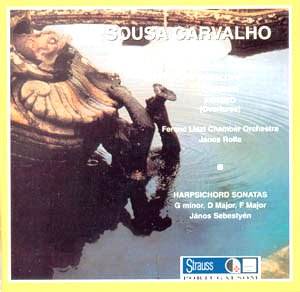JOÃO DE SOUSA CARVALHO (1745 -
1798)
OVERTURES/HARPSICHORD SONATAS
Penelope (overture) * [8.02]
L'Eumene (overture) * [7.00]
Perseo (overture) * [6.24]
Toccata in g minor ** [7.24]
Sonata in D major ** [8.39]
Sonata in F major **
[8.40]
 * Ferenc Liszt Chamber
Orchestra/János Rolla
* Ferenc Liszt Chamber
Orchestra/János Rolla
** János Sebestyén/harpsichord
rec: May - June 1984 (overtures); July 1984
(harpsichord).
 STRAUSS CD SP 4161
[47.06]
STRAUSS CD SP 4161
[47.06]

Portuguese baroque music was dominated by Italian opera, and the three overtures
on this CD bear witness to this influence. Composed between 1773 and 1782,
these three overtures follow the classical Italian model with three sections,
fast, slow, fast. There is little in these works that makes them stand out
from the many other Italian opera overtures - they sound as though they could
have been written by Mozart. The music is efficient and agreeable, but eventually
lacking in depth. The recordings of these overtures are not excellent, with
a flat sound that lacks highlights - bear in mind that this is an analogue
(ADD) recording made in 1984.
However, Sousa Carvalho's harpsichord works are far more interesting. This
disc contains all of his known works for the keyboard, and it is a shame
that he did not write more such music. There is real verve and energy in
these short works, which are not unlike the harpsichord sonatas of Domenico
Scarlatti.
The Toccata in G minor is a delightful work in two movements,
allegro and andante. Like many of Scarlatti's binary sonatas,
these two movements fit perfectly together. While not filled with the same
types of difficulties, the rhythmic elements in this piece are quite interesting.
Sousa Carvalho was writing at a time that was at the crossroads between the
baroque and the pre-classical periods, and the "classical" sonata was in
development. Movements for this type of work were no longer named by the
dance rhythms they were based on. The classical sonata of three movements
was becoming fashionable, and the two sonatas on this disc, the Sonata
in D Major and the Sonata in F Major, fit that form, each opening
and closing with an allegro; the former with a larghetto in
the middle, and the latter an andante.
These two sonatas are typical of the harpsichord idiom, and alternate virtuoso
passages, with more rhythmic effects, and melodic passages. There is a certain
cuteness in the slower movements of these sonatas. The larghetto of
the D Major Sonata has a music-box sound to it, highlighted by the
timbre of the harpsichord playing in a high register. The andante
of the F Major Sonata recalls some of Bach's sarabandes in
its melodic structure.
The performance of all three of these harpsichord pieces is joyful and bright,
and the recording is quite good. János Sebestyén shows a mastery
of harpsichord technique, and his choices in ornamentation and registration
(there is an interesting use of a lute stop in the F Major andante) are quite
judicious.
While the overtures are essentially forgettable, the harpsichord works are
very satisfying, and show a composer who, unfortunately, left us only these
works for keyboard.
Late baroque orchestral and harpsichord music.
Kirk McElhearn
CONTACT DETAILS
Orders can be placed via
info@strauss.pt
The prices are: UK pounds-6 and US dollars-10 (freight not included).
The transport costs are:
Freight --- till 3 cd's --- not registered --- £2.40;registered----
£3.50
For USA --$ 10
Freight --till 3cd's -- not registered ---$5 ;registered ---- $6.80
Orders can come by fax to
fax number 351 21 7142353
or by mail 'for attention of Eduarda Martins' to the address:
Strauss, S.A.
Rua Adelaide Cabete, 3C,
1500-023 LISBOA
Portugal.
Credit cards are accepted with the name of the buyer, credit card number,
validity date and type of card. They accept Visa or American
Express.
Orders and enquiries for this disc to
attention of Eduarda Martins
Strauss S.A.
Rua Adelaide Cabete 3-C
1500 023 Lisboa
Portugal
phone 01 7151151 - 7143490
fax 01 7141723

